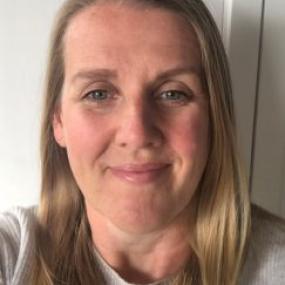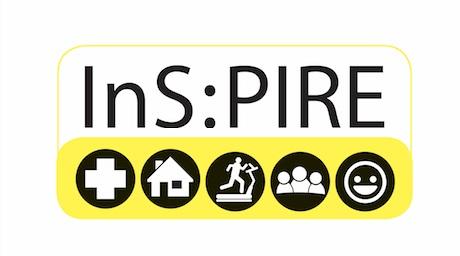Establishing an ICU follow up service and the COVID response – Tea & cake to Teams!

Dr Lucy Hogg is a Critical Care and Anaesthetic Consultant who works for NHS Fife. She leads the ICU follow up service InS:PIRE.
“I could take a look at that!” were the fateful words I uttered which led me and my colleagues on a journey of discovery into ICU follow-up and ultimately in us establishing a new service in our hospital.
It was 2015 and I had only recently started working as a Consultant in the Victoria Hospital in Fife. Guidelines for the Provision of Intensive Care Services (GPICS)1 had just been published and my department had divided the document up to review. I had been allocated Chapter 3 which covered the patient pathway including follow up and rehabilitation. My conclusion was…”we don’t do much of this, but the guideline suggests that we should aspire to… I could take a look at that!”
At that time our ICU had a motivated charge nurse who called patients once they were home and conducted a patient satisfaction survey. There was very little time and resource allocated to this and it relied on Colette’s dedication. I had little knowledge about follow up, it was largely limited to hearing accounts from individual institutions at educational meetings. I really had no idea where to begin and, at best, I thought we might be able to offer a peer group type meeting or a doctor led clinic.
It was through sheer good luck and timing that the outcome has been very different.
I received an information email later that year from the Scottish Intensive Care Society about an education day being run in Glasgow Royal Infirmary by Dr Tara Quasim and Dr Joanne McPeake about InS:PIRE (Intensive Care Syndrome: Promoting Independence and Return to Employment) -the ICU follow up programme they had established. “Great!” I thought. “Someone else has figured this all out, maybe they’ll have some good ideas that I can pinch!” I popped in a study leave request and sent off my application to attend. It was followed up by an application form. I was uncertain at this point exactly what I was applying for, so I erred on the side of optimism! Yes -we could establish an MDT including pharmacy, psychology and physiotherapy. Yes -I had an executive sponsor. Yes -we had rooms that we could use, and catering facilities and toilets yes, yes, yes!
When we were selected as a site to receive Health Foundation funding to participate in the InS:PIRE “scale -up” project. My optimism suddenly seemed somewhat misplaced. Some quick enquiries to members of the MDT were thankfully met with enthusiasm but we also had to forge new links with departments we had never worked with before, like psychology. Having assembled our MDT, much of the early days were spent sorting out logistics: Rooms, chairs, projectors and cups, a phone line and a way of allocating and administering funding….. the list went on. By January we seemed set and the first group of patients and carers were invited. We started with 10 invitations and to our disappointment only three couples attended. The atmosphere was very formal in spite of our best efforts and no-one mentioned delirium. It was like the elephant in the room.
We have learnt from these early experiences and the process has evolved and become more suited to our local needs over time. Four years later, we have now established a well-oiled format for our face-to-face meeting. We are much more explicit at the outset about the problems we expect people may be facing and we have found that, in general, people really want to talk about their experiences. By pointing out the elephant in the room early on, we have found that people are relieved to discuss the whole menagerie of issues they have. The formality has gone, and the atmosphere is generally relaxed and positive.
We have moved location within the hospital in a bid to find the right mix of spaces to mingle, run exercise classes and chat and more private rooms to have one to one consultations (surprisingly difficult to come by!). We have supported five volunteers through the hospital volunteering programme and we have won hospital awards (Colette Ross’ work was recognised as the winner of the NHS Fife nursing and midwifery award and the InS:PIRE volunteers were also nominated in 2018) . Most importantly we were able to make a successful case to the board that the service should have permanent funding.
Just when we were getting comfortable, the COVID 19 pandemic knocked the wind out of our sails. How could we deliver this group programme if we couldn’t invite patients to the hospital? How would the informal vibe work at all on Zoom or Teams? I will be the first to say that I was very pessimistic about taking it to a virtual platform, but I will also be the first to admit that my misgivings were unfounded.
We ran our first “virtual cohort” in September 2020 and were surprised and pleased at how readily the patients engaged with the process. It seemed that months of mastering Zoom quizzes and family chats had digitally upskilled our patients who were more than comfortable using links to join the meeting, muting and unmuting and conversing via email.
The team also adapted remarkably quickly. There were the inevitable teething problems as we learned to “screen-share” our presentations but changes to materials were quickly made to allow the information to be delivered online.
There are lots of ways that the virtual group actually works better -no-one has to travel and the complaints about car parking have disappeared. The whole group gets to hear from everyone and so all of the attendees share all of the experiences, not just the smaller conversations that inevitably took place between people, who naturally navigate towards those who they think they will have common ground with, in a crowded room. The use of email as a tool to communicate with patients has opened up the opportunity to send digital links to resources and also for patients to access 1:1 conversations with the MDT that wasn’t previously available. Collecting feedback to inform changes and plan future groups is also much easier now that we have developed an electronic form for doing it.
As with anything there are disadvantages too. The difficulty of what to do when a person gets emotional -where a hand on a shoulder or the offer of a tissue would have silently and more subtly offered empathy, any expression of concern now has to be more explicit and verbalised. This feels a little clumsy at times and certainly isn’t as good “virtually”.
Turning up at all can also be more challenging -especially for those less digitally able patients -for whom a Teams call just seems too much, or for those without access to WiFi when a 1 hour video call will consume much of their data allowance for the month. They would (understandably) far rather keep it for other uses.
The visit to ICU always offered a sense of closure for patients who wished to return. Making sense of the environment and finding missing pieces of the jigsaw which had been lost in the delirium always seemed to allow patients to move on. We have a “virtual tour” as part of our online format but I’m not sure it’s the same.
Where we will be in another year’s time is anyone’s guess. I would hope that we can return to some form of face-to-face meeting, but I also think that we have discovered some important new digital skills which we will hopefully blend into whatever our service ultimately becomes. What is certain is that the volume of work has increased and the recognition of the sequelae of critical illness is far more prominent now than it was before the pandemic. I think demand for this sort of service is only going to increase and probably not just for patients who have been in ICU; a lot of the issues we explore are relevant to anyone who has experienced a long or severe illness associated with an acute hospital admission.
Like with all of life at the moment we will just take one day at a time!"
References
1. Guidelines for the provision of Intensive Care Services Edition 1.1, Faculty of Intensive Care Medicine. 2016 (now superseded by Edition 2, 2019)
Acknowledgements
The InS:PIRE concept was developed and piloted by Dr Tara Quasim and Dr Joanne McPeake (Glasgow Royal Infirmary). We are delighted in Fife to now be part of the InS:PIRE network across Scotland and thank them for including our hospital in the scale up project.
The NHS Fife InS:PIRE team is a multidisciplinary team comprised of Dr Caroline Ferguson, Dr Mike McMahon, Charge Nurse Colette Ross, Dr Jackie Fearn (psychology), Kerry Murphy, Marie Stein (Physiotherapy), Alan Timmins (Pharmacy), Alison Gibb, Cliona McGreevy (Dietetics), Jamie Mason (Fife Leisure), Sandra Morris (Fife Carers) and our volunteers Nicky Headrick, Margheurite Henderson and Anne and Willie Millar.

